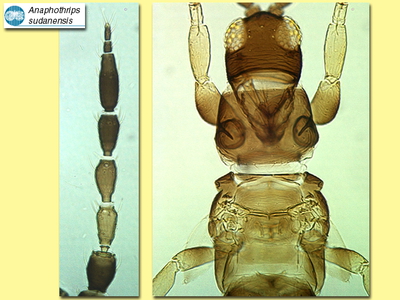Figures
Fig. 1 Antenna, head and thorax
Fig. 2 Fore and hind wing
Fig. 3 Sternite V-VII with sternal pore plates (male)
Fig. 4 Tergite VIII and IX (female)
Species
Anaphothrips sudanensis Karny
Biology
This pest thrips breeds on the leaves of many grasses and cereal crops, including sugar cane, but apparently not usually on rice. Feeding damage involves linear markings on the leaves.
Distribution
This species has been found throughout the tropics and subtropics, and described under more than 10 different names. It is established in northern Australia.
Recognition
Sharply bicoloured; mainly brown but with abdominal segments III-V yellow, also tarsi and tibiae, and antennal segments III & IV; forewings (when present) pale but with second quarter light brown. Head slightly longer than wide, with no long setae. Antennae 8-segmented, III & IV with small forked sense cone; VII+VIII shorter than VI. Pronotum with no long setae. Metanotum finely reticulate, median setae arising near midpoint of sclerite. Tarsi all 2-segmented. Forewings fully developed or reduced to a small lobe; when present, first vein with 3 setae widely spaced on distal half of forewing, second vein with about 7 setae. Tergite VIII with posteromarginal comb of long and regular microtrichia; X with complete longitudinal division medially. Male similar in colour and structure, but sternites III-VIII with distinctive C-shaped glandular area.
Related species
The genus Anaphothrips should probably be restricted to a group of species feeding only on grasses. However, traditionally the genus has been used for a wide range of species that have no long setae on the pronotum. In this broad sense there are several native species of Anaphothrips in Australia, but these are probably not closely related to the true grass-living Anaphothripsspecies.





